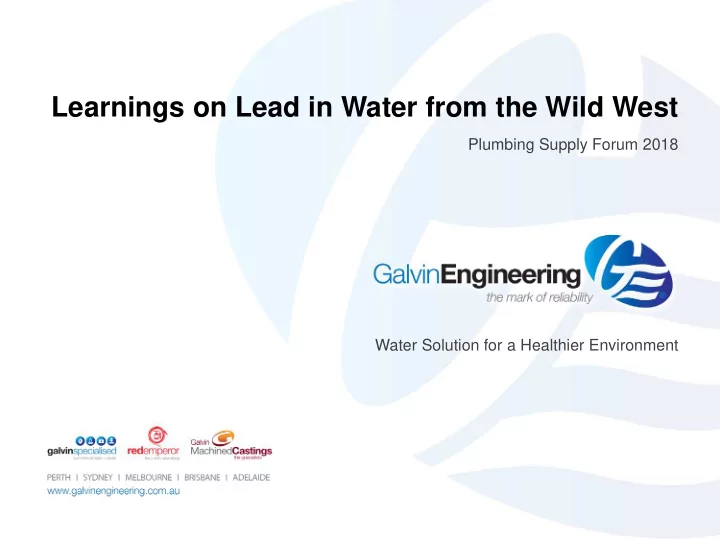

Learnings on Lead in Water from the Wild West Plumbing Supply Forum 2018 Water Solution for a Healthier Environment
My chat is probably a bit redundant – it was like this!
My chat is probably a bit redundant – it’s now this!
1. Confusion over what this number means? 0.01 0.01mg/L = Maximum allowable concentration of lead in drinking water. Taken from the Australian Drinking Water Guidelines (ADWG). Based on a World Health Organisation (WHO) assessment and was determined by the need to protect the groups most at risk - young children, infants and pregnant women.
1. Confusion over what this number means?
1. Confusion over what this number means? Different views amongst experts, authorities and media over whether an individual test finding of > 0.01 means there is an actual health risk, or whether it more of a lifetime measure. To answer this you really need to consider: The typical users and their usage patterns, That the WHO says water is just 20% of lead intake, The long term health findings. Action – Agreement on the health issue … but by who?
2. Confusion over in-field water testing methods? Some testing being done in the field in Australia is creating public concern about elevated levels of lead in drinking water. This has the potential to impact opinion regarding the possible effects on public health, and the suitability and safety standards of plumbing products & practices. The methods used vary dramatically, and it is possible that some testing techniques may not be adequate in generating accurate data on metal levels in water.
2. Confusion over in-field water testing methods? Opposing sides claim to use the methods set-out in Australian Standard - AS/NZS 5667.5:1998 – Water Quality – Sampling . So who is right? PCH – WA Health or John Holland Aldi – QBCC or Aldi Perth Stadium – Sunday Times or WA Health International – USA or Canada or Germany or … Or is it somewhere in between?
2. Confusion over in-field water testing methods? What do the manufacturers do now? It’s full on and takes a lot of time and money. AS/NZS 3718 Materials in contact with drinking Copper Alloy Material Composition Dezincification-Resistant water Clause 2.2.4 Clause 2.2.5 Clause 4.7 Clause 2.2.4 (a): Clause 2.2.4 (b) Clause 2.2.4 (c) Clause 2.2.4 (d) Compliant with AS/NZS Compliant with AS 2345 Castings shall comply with Hot Pressings shall comply Extrusions shall comply Tubular Components shall 4020 AS 1565 with AS 1568 with AS 1567 comply with AS 1572 Test methods ensure Max Pb content ranges Max Pb = 0.07% Max Pb content ranges delivery of water is in Max Pb content ranges from 0 - 22% from 0 - 3.5% We specify C26130 accordance with from 0 - 4.5% Of the alloys with Of the alloys with Of the alloys with which includes arsenic ADWG Arsenic (implying DR) Arsenic (implying DR) and has 0.05% Pb Arsenic (implying DR) Max Pb = 4.5%. Max Pb = 3.5%. Max Pb = 3.5%. This This grade is deemed Pb Max Allowable We specify C85210 alloy = C35200, and is We specify C48600 DR compliant within = 10 µ g/L which has Max Pb the one we use which has Max Pb 2.5% AS2345 (micrograms per Litre) 4..5%
2. Confusion over in-field water testing methods? Unlike AS4020, AS/NZS 5667.5 can be silent or very vague on key sampling and testing processes. Needs to better address: The flushing and/or stagnation periods The volume of water extracts tested Site specific issues Misinformed public debate in the media will continue until a more detailed and scientific method is not agreed on. Where possible, alignment with AS4020 would be useful. Action – review of AS/NZS 5667.5 … but by who?
3. Confusion over what affects lead levels in water? Many factors contribute to the variability of lead concentration results from drinking water testing, including: the type of materials used in the plumbing system, the age & complexity of the plumbing system, usage patterns of inhabitants, stability of flow rates in the system, stagnation and dead-leg areas, chemicals introduced into the water supply (eg. chlorine), fluctuations in water quality (pH and alkalinity), Build up of a protective mineral crusting over time on the inside of pipes.
3. Confusion over what affects lead levels in water? Many authorities and researchers from around the world speak on these topics: Health Canada USA’s EPA German Ministry of Health Including a lot of good research in Australia by groups such as the Macquarie University. However, there is still a long way to go in understanding what affects lead levels in water. Action – agreement on factors affecting lead … but by who?
Thanks for listening and feel free to call We are passionate about Water Solutions for a Healthier Environment, so give us a call to share your thoughts and ideas on this important issue for our industry. Chris Galvin – 0413 620 794
Recommend
More recommend